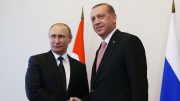The occupation of Afghanistan by the Soviets and the occupation of Iraq by the Bush administration prepared the ground for the germination and flourishing of terrorist organizations in the Middle East. As opposed to Afghanistan, post-war Iraq still had the chance for regeneration, since Sunnis, Shiites and Kurds succeeded in assembling under the same parliament to reconstruct their state structure in the post-Saddam period. Although there was no financial obstacle for the reconstruction of the state in the oil-rich country, the only aim of the al-Maliki administration was to dissolve the civilian and military bureaucracy of the Saddam period, while segregating the Sunni population instead of constructing an inclusive civilian democracy. Thus, due to this militant Shiite policy, terrorist organizations were able to expand in Sunni lands, which were devastated first by the U.S. occupation and then the sectarian Shiite administration. The existent chaos was further deteriorated by al-Qaida’s terrorist attacks against the Shiite population and the retaliatory attacks of the Shiites against the Sunnis at the end of which the death of 100 people per day became a common occurrence in Iraq.
The devastating fire in Iraq and Afghanistan spread to Syria by the beginning of the Syrian civil war, which provided additional lands and human resources for terrorist organizations. At this very point of gloomy events, a monstrosity emerged – DAESH – which like the villains of Hollywood movies slaughtered innocent people, enslaved women, desecrated every maxim of Islam and abused various means of communication for black propaganda. Defining DAESH as the most fearsome monster of the modern era, Western states declared that their struggle against that devil would last at least two decades.
DAESH almost never attacked the Syrian regime directly; to the contrary, they were oriented under the political agenda of Iran toward northern Syria and thus toward the Syrian borders of Turkey. Soon enough, most land controlled by DAESH was seized by the PKK via the backing of the U.S. Strengthening the PKK in northern Syria and their alliance with the U.S. disquieted the countries of the region, including the Syrian regime, Iran and Turkey. Russia, on the other hand, does not seem to be very worried about the rise of the PKK in Syria under the leadership of the U.S.
As if struggling against a specter, a coalition of 60 countries bombards Syrian land, the PKK and Democratic Union Party (PYD) commit ethnic cleansing in the lands of Arabs and Turkmens, and the U.S. as a democratic force almost solely relies on yet another terrorist organization in its struggle against DAESH. Both of these terrorist organizations, on the other side of the coin, continue to commit terrorist attacks against military elements and the civilian population of Turkey.
The world powers could not have read the democratic demands of the Syrian people right. By reading the issue at hand from their own points of view, Iran and Turkey, on the other hand, could have not found a common ground for the resolution of the Syrian crisis.
Yet, Turkey’s Jarablus offensive destroyed the image of DAESH as an almost invincible force and abolished the PKK’s pretext of “struggling against evil” to construct its own state in northern Syria. Turkey taking the most active role on the battlefield demonstrates that the Syrian civil war and the refugee crisis can only be resolved by ensuring the territorial integrity of Syria.
In short, Turkey’s Jarablus offensive proves that only through the realist policies of international and regional powers could DAESH be eliminated and the territorial integrity of Syria ensured.
Author: İHSAN AKTAŞ
Source: www.dailysabah.com



Be the first to comment at "Who fights ISIS? The truth"